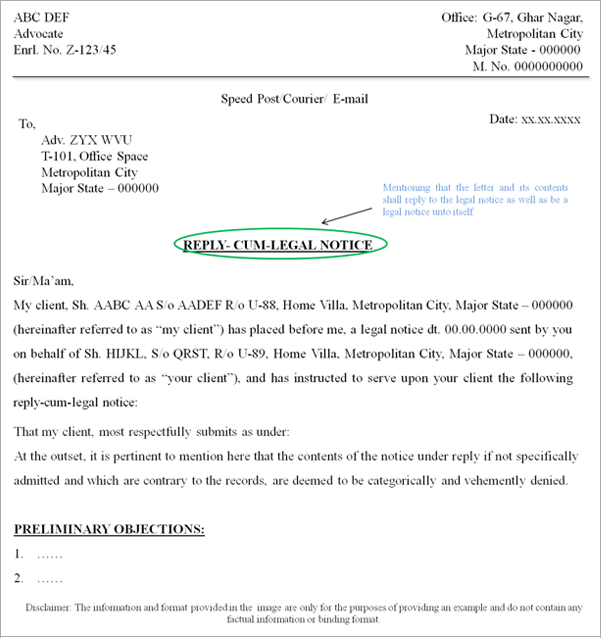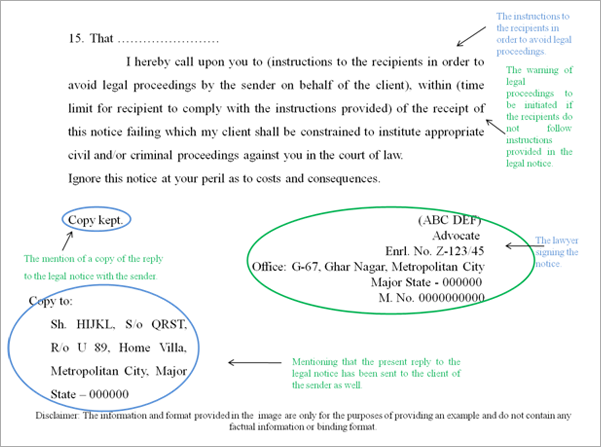Receiving a legal notice is not a matter of concern; in fact it is a matter to be dealt with utmost calm. Replying to a legal notice is not a source of worry.
In the field of practicing law, it is common to be drafting legal notices on a regular basis for clients. It is just nearly as common to be drafting replies of legal notice(s) received by the client. The reply to a legal notice does not necessarily follow a very different format or pattern than that of legal notices, but it does require few additions. These additions are focused on relaying the client’s side of the version of events in question.
The reply to a legal notice is not as common as drafting notices as the parties either resolve the matter after receipt of the legal notice, or they end up before the court of law for the resolution. Replying to a legal notice however does become commonplace for when the legal notice received is not only vexatious but also threatening in nature due to its false contents. This is often because legal proceedings are long and expensive and these elements alone are enough to cause worry and distress to a layman.
So, when a layman rushes to a lawyer with the legal notice, how is the reply to a legal notice drafted? The format and language of the reply to a legal notice does not change much from that of a legal notice itself. It includes the general format of a legal notice and incorporates some additional details and paragraphs about the legal notice received, its nature etc.
The Body of the Reply
Replying to a legal notice is the mix of the process of replying to a written statement and drafting of notice. The reply starts with the mention of the basic details of the legal notice received - date, details of the entity on behalf of whom the legal notice was sent etc. It may also contain mention of claims of legal notice received as false, or something of similar nature. The legal notice then starts with preliminary objections and then moves on to “reply on merits” - replying to the legal notice point/paragraph wise, and may not necessarily contain such a heading. This process is very similar to the drafting of a written statement or rejoinder.
The points in the body of the notice start with the client's version of the events under discussion in the legal notice received. The legal notice then continues in this manner, filling in all the details of the client’s version of the events in question.

Concluding the Reply
Once the entire body of the legal notice is prepared incorporating the client’s version of the events, the format of the legal notice where the law relied upon for remedy is included. These are the general last few paragraphs of the legal notice where the sender of the reply to the legal notice lays down the instructions for the entity who receives the legal notice upon such receipt, along with warning of consequences if the instructions are not complied with.
The difference here is that the reply to the legal notice specifically mentions that the legal notice shall be sent to both the client as well as the lawyer who sent the legal notice on behalf of his client. This is done to ensure that the reply is received by all parties concerned - the lawyer who sent the notice as well as the entity who engaged the lawyer to send the concerned legal notice. This is done to ensure proper conveyance of necessary communication. The lawyer is marked and not just the client because when engaging a lawyer there is an agreement between the lawyer and his client that the lawyer acts as a representative of the client.

Conclusion
Replying to a legal notice does not happen as much as sending a legal notice does. Nonetheless, they are an important part of proceedings. They allow the sender of the reply to a legal notice, the opportunity to claim before the court of law that they have been relaying their versions of the event, and stand by it, from the get go. However, this may be considered by some to be trivial or not necessary at all, and sometimes to even just wait for the court summons and appear before the court itself and plead. Sending a reply to a legal notice may also lead to reaching a resolution - which is the intention of the entire process. All in all, replying to legal notices has few format changes and works on the same principle as a legal notice.